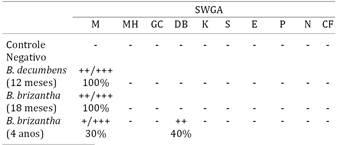Abstract:
Animals grazing Brachiaria spp. commonly present foamy macrophages isolated or grouped in the liver, and crystals within biliary ducts. The pathogenesis of formation and the nature of the material stored in these cells however are not completely known. Through lectin histochemistry evaluation, steroidal saponins (secondary glycosylated metabolites) have been identified in the crystals and within the cytoplasm of the foam cells, which are probably liable for damaging the liver, leading to accumulation of phylloerythrin. This study aims to standardize and characterize the use of lectin histochemistry to detect glycosylated metabolites in tissues of buffaloes kept on different Brachiaria spp. pastures in Brazil. Fragments of liver and mesenteric lymph node from 40 buffaloes were analyzed: 10 buffaloes that were kept in predominant pasture of B. decumbens for 12 months; 10 buffaloes that were kept in pasture with a predominance of B. brizantha for 18 months; 10 buffaloes that were kept on pasture of B. brizantha for about four years; and as a negative control, 10 buffaloes that were maintained on native pasture without Brachiaria spp. since birth. Fourteen lectins were tested (Con-A, SBA, WGA, DBA, UEA, RCA, PNA, GSL-I, PSA, LCA, PHA-E, PHA-L, SJA and SWGA), in a total of 1120 evaluated samples. Previous studies demonstrated that PNA showed great binding reactivity for foamy macrophages in cattle and sheep. In the present study, SWGA showed high specificity and marked binding reactivity for foamy macrophages; WGA, GSL, PHA-E and PHA-L showed moderate to marked reactivity, but low specificity for foamy macrophages. The other lectins had not relevant reactivity or specificity. Moreover there was no relevant reactivity difference between the collected samplesd from buffaloes that grazed B. decumbens for 12 months and Brachiaria brizantha for 18 months. However the decreased presence of foamy macrophages and its lectin histochemical binding in animals that fed on B. brizantha for a longer time, indicates that the buffaloes can pass through an adaptation process according to the plant intake time. Lectin histochemistry analysis can be used to characterize the material stored in foamy macrophages present in liver and mesenteric lymph node of buffaloes that graze on Brachiaria spp. pastures and helps to clarify the pathogenesis of these cells.
Index Terms:
Lectin histochemistry; liver; mesenteric lymph node; buffaloes; Brachiaria spp.; saponins

 Thumbnail
Thumbnail
 Thumbnail
Thumbnail
 Thumbnail
Thumbnail
 Thumbnail
Thumbnail
 Thumbnail
Thumbnail





